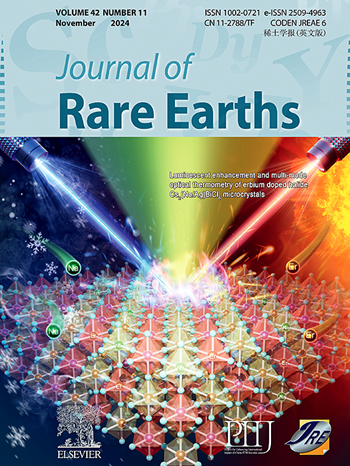从热释光评估陷阱深度的改进方法
IF 7.2
1区 化学
Q1 CHEMISTRY, APPLIED
引用次数: 0
摘要
稀土掺杂无机化合物由于稀土离子的多能级特性,在持续发光材料家族中占有重要地位。将稀土离子或本禀缺陷所产生的陷阱能级与基体的电子结构相匹配是关键的研究目标之一,因此热致发光测量成为研究陷阱深度的一项重要技术,而陷阱深度是决定持续发光和光激发发光性能的重要参数之一。然而,不同热释光方法得到的陷阱深度结果差异较大,不具有可比性。本文对不同的热释光方法进行了分析,选择并改进了传统的Tm/500峰位法为E =(−0.94lnβ+30.09)kTm。只需要增加实验升温速率(β),但在大多数情况下精度大大提高。这种简便、准确的方法将加速发现新型稀土掺杂材料。本文章由计算机程序翻译,如有差异,请以英文原文为准。

An improved method to evaluate trap depth from thermoluminescence
Rare earth-doped inorganic compounds contribute mostly to the family of persistent luminescent materials due to the versatile energy levels of rare earth ions. One of the key research aims is to match the trap level stemming from the doped rare earth ion or intrinsic defects to the electronic structure of the host, and therefore thermoluminescence measurement becomes a radical technology in studying trap depth, which is one of the significant parameters that determine the properties of persistent luminescence and photostimulated luminescence. However, the results of trap depth obtained by different thermoluminescence methods are quite different so that they are not comparable. Herein, we analyzed different thermoluminescence methods, selected and improved the traditional peak position method of Tm/500 to be E = (−0.94lnβ+30.09)kTm. Only the experimental heating rate (β) is needed additionally, but the accuracy is improved greatly in most cases. This convenient and accurate method will accelerate the discovery of novel rare earth-doped materials.
求助全文
通过发布文献求助,成功后即可免费获取论文全文。
去求助
来源期刊

Journal of Rare Earths
化学-应用化学
CiteScore
8.70
自引率
14.30%
发文量
374
审稿时长
1.7 months
期刊介绍:
The Journal of Rare Earths reports studies on the 17 rare earth elements. It is a unique English-language learned journal that publishes works on various aspects of basic theory and applied science in the field of rare earths (RE). The journal accepts original high-quality original research papers and review articles with inventive content, and complete experimental data. It represents high academic standards and new progress in the RE field. Due to the advantage of abundant RE resources of China, the research on RE develops very actively, and papers on the latest progress in this field emerge every year. It is not only an important resource in which technicians publish and obtain their latest research results on RE, but also an important way of reflecting the updated progress in RE research field.
The Journal of Rare Earths covers all research and application of RE rare earths including spectroscopy, luminescence and phosphors, rare earth catalysis, magnetism and magnetic materials, advanced rare earth materials, RE chemistry & hydrometallurgy, RE metallography & pyrometallurgy, RE new materials, RE solid state physics & solid state chemistry, rare earth applications, RE analysis & test, RE geology & ore dressing, etc.
 求助内容:
求助内容: 应助结果提醒方式:
应助结果提醒方式:


